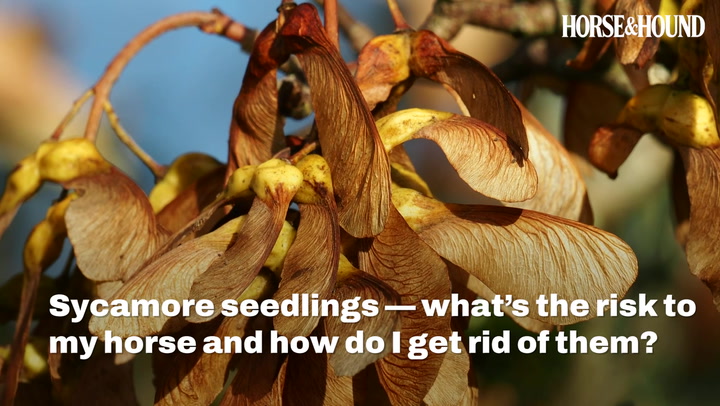Sycamore poisoning, or atypical myopathy, caused by the ingestion of sycamore seedlings or seeds can be fatal to horses, and while owners need to be on the lookout for any signs all year round, the disease is more common in the spring and autumn months.
Follow our guide to help ensure your paddocks are kept as low-risk as possible…
 Watch the video
Watch the videoBut first, what is atypical myopathy?
Atypical myopathy is a often fatal muscle disease, thought to be caused by the ingestion of hypoglycin A, a toxin contained in sycamore seeds and seedlings.
Vets have recently reminded horse owners to take action to minimise the risks of atypical myopathy as spring is a common time for horses to suffer the potentially fatal condition, as sycamore seedlings start to emerge from the ground.
Young horses appear to be more susceptible, as are those being grazed on parched land.
What shall I do if I spot seeds or seedlings?
Getting rid of both the seeds and any fresh sycamore seedlings (depending on the time of year) is vital. If spotted in an area where horses are grazing, it is advised to remove the horses from the pasture immediately, by bringing them in or fencing off the infected area.
The seeds can carry some distance on the wind, so do not assume that if you don’t have sycamore trees in your horse’s field, your horses at not at risk.
If you are struggling to identify sycamore seeds, get in touch with an expert, such as a tree surgeon or someone from a local garden centre, who can help you confirm which tree the seed in question has come from.
It is possible to test seeds or seedlings to identify their levels of the hypoglcyin A toxin through the Royal Veterinary College.
How do I get rid of them?
Once you have identified you have sycamore trees in your local area, one of the of the most effective (certainly cost-wise) methods of removing the seeds is to hoover them up from the ground — usually by hand.
While time consuming, this is the only way you can guarantee the seeds have been effectively removed from the area. For a more long-term solution, employing someone to come and remove any sycamore trees on your own land is an option as long as the tree is not subject to a protection order.

A sycamore seedling. Credit Alamy.
Mowing areas of pasture is one way to trim the young seedlings, but the cuttings will need to be collected and this will not prevent them from growing again.
Using a certified weed killer (which is known to kill sycamores) can also get rid of the sycamore seedlings, but is less convenient for many due to the rest period the pasture will need following being sprayed. It is advised that you speak to a professional herbicide expert prior to purchasing a weed killer solution.
An example of a weed controller suitable for equestrians is Envy from Dow AgroScience — as with any chemical, it is vital to follow the resting and usage instructions.

Dow AgroScience Envy Herbicide
This weed controller is suitable for use on paddocks grazed by horses.
What else can I do to protect my horse?
The Blue Cross education team has worked with veterinary experts at Bourton Vale Equine Clinic to provide the following advice to help horse owners prevent atypical myopathy:
- Feed forage, such as hay in parched fields, off of floor in haynets or feed racks
- Do not over stock fields so horses have access to good grass
- Limit turnout, ideally keeping horses in over night
- Section off areas around poisonous trees and collect and dispose of leaves and seeds safely away from horses
- Remove young sapling plants
- Be vigilant of the potential signs of this disease and act quickly if your horse becomes poorly
- Ensure you check your horse multiple times a day
- Check your insurance cover for veterinary care is up to date
You might also be interested in:

Atypical myopathy: what you need to know right now to keep your horses safe

Atypical myopathy: ‘Be vigilant this spring’ to protect your horse
Owners have been urged to take steps to combat this often fatal disease

‘Know your horse’: how simple actions can save your horse’s life
‘If you can prevent deterioration until the vet arrives, you're going to do such an amazing thing’

Subscribe to Horse & Hound magazine today – and enjoy unlimited website access all year round
Horse & Hound magazine, out every Thursday, is packed with all the latest news and reports, as well as interviews, specials, nostalgia, vet and training advice. Find how you can enjoy the magazine delivered to your door every week, plus options to upgrade your subscription to access our online service that brings you breaking news and reports as well as other benefits.





